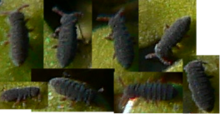The order Poduromorpha is one of the three main groups of springtails (Collembola), tiny hexapods related to insects. This group was formerly treated as a superfamily Poduroidea.
| Poduromorpha | |
|---|---|

| |
| Podura aquatica (Poduridae) | |
| Scientific classification | |
| Domain: | Eukaryota |
| Kingdom: | Animalia |
| Phylum: | Arthropoda |
| Subclass: | Collembola |
| Order: | Poduromorpha |
| Superfamilies | |
| |
They can be best distinguished from the other springtail groups by their body shape. The Symphypleona are very round animals, almost spherical and the abdominal segments are not visible. [1] Both Entomobryomorpha and Poduromorpha are long springtails with six visible abdominal segments. While Entomobryomorpha have the first thorax segment reduced, Poduromorpha retain all three. [1] The Poduromorpha also tend to have short legs and a plump body, but more oval in shape than the Symphypleona. Their name means ‘foot tail formed’, deriving from their short, flat, furcula.
Systematics edit
The Poduromorpha were, as Poduroidea, united with the Entomobryomorpha (then called Entomobryoidea) in a group called "Arthropleona", but this has more recently turned out to be paraphyletic. Actually the Entomobryomorpha, the Poduromorpha, and the third springtail lineage – the Symphypleona – are equally distinct from each other. Their treatment at equal taxonomic rank reflects this. Their rank has also varied a bit. When the springtails were still believed to be an order of insects, the "Arthropleona" and the Symphypleona were treated as suborders.[2]
List of families edit
Includes fossil families.
Superfamily Neanuroidea
- Family Brachystomellidae
- Family Neanuridae
- Family Odontellidae
Superfamily Poduroidea
- Family Poduridae
Superfamily Hypogastruroidea
- Family Hypogastruridae
- Family Pachytullbergiidae
- Family Paleotullbergiidae
Superfamily Gulgastruroidea
- Family Gulgastruridae
Superfamily Onychiuroidea
- Family Onychiuridae
- Family Tullbergiidae
Superfamily Isotogastruroidea
- Family Isotogastruridae
Footnotes edit
- ^ a b Stephen P. Hopkin (2007). A Key to the Collembola (springtails) of Britain and Ireland. FSC. ISBN 978-1-85153-220-9.
- ^ See references in Haaramo (2008).